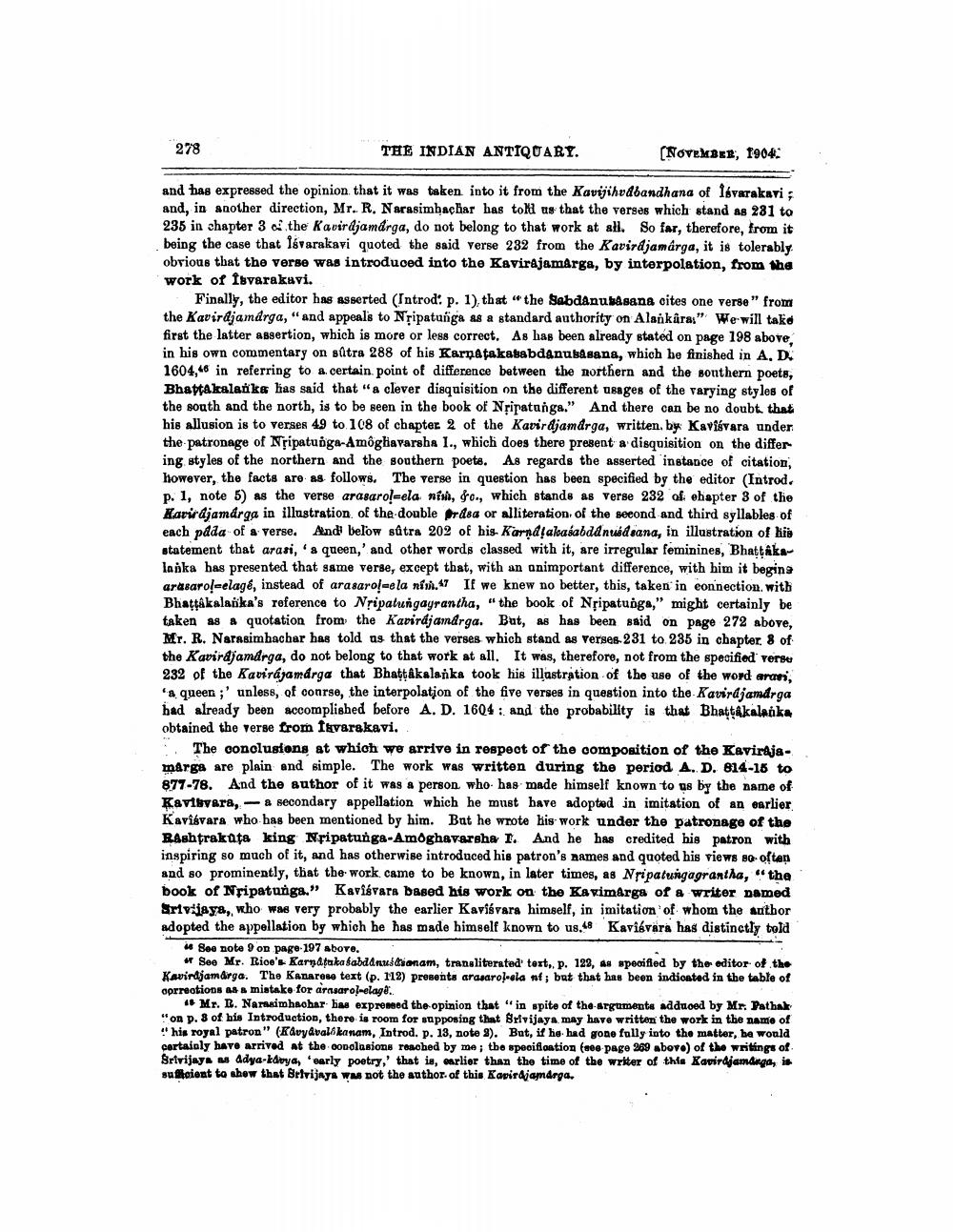________________
278
THE INDIAN ANTIQUARY.
(NOVEMBER, 1904:
and has expressed the opinion that it was taken into it from the Kavijihvdbandhana of Isvarakavi ; and, in another direction, Mr.R. Narasimhachar has to as that the verses which stand as 231 to 235 in chapter 3 of the Kavir djamdrga, do not belong to that work at all. So far, therefore, from it being the case that Isvarakavi quoted the said verse 232 from the Kavirdjamarga, it is tolerably obvious that the verse was introduced into the Kavirajamarga, by interpolation, from the work of Isvarakavi.
Finally, the editor has asserted (Introd: p. 1), that "the Sabdanubasana cites one verse" from the Kavirajamdrga, "and appeals to Nripatunga as a standard authority on Alankúra." We will take first the latter assertion, which is more or less correct. As has been already stated on page 198 above, in his own commentary on sutra 288 of his Karnatakababdanusasana, which he finished in A. D. 1604,48 in referring to a certain point of difference between the northern and the southern poets, Bhattakalatka has said that "a clever disquisition on the different usages of the varying styles of the south and the north, is to be seen in the book of Nripatunga." And there can be no doubt that his allusion is to verses 49 to 108 of chapter 2 of the Kavir djamdrga, written by Kavisvara under the patronage of Nipatunga-Amôghavarsha I., which does there present a disquisition on the differ ing styles of the northern and the southern poets. As regards the asserted instance of citation, however, the facts are as follows. The verse in question has been specified by the editor (Introd. p. 1, note 5) as the verse arasaro!ela nis, fc., which stands as verse 232 of chapter 3 of the Karirdjamarga in illustration of the double Ardea or alliteration of the second and third syllables of each pada of a verse. And below sûtra 202 of his Karndļakasabdd nud sana, in illustration of his statement that arasi, ' a queen,' and other words classed with it, are irregular feminines, Bhattakalanka has presented that same verse, except that, with an animportant difference, with him it begins arasaro-elage, instead of arasarol=ela niti.7 If we knew no better, this, taken in connection, with Bhattakalanka's reference to Nripatungayrantha, " the book of Nripatunga," might certainly be taken as a quotation from the Kavirájandrga. But, as has been said on page 272 above, Mr. R. Narasimhachar has told us that the verses which stand as Verses 231 to 235 in chapter. 8 of the Kavirajamdrga, do not belong to that work at all. It was, therefore, not from the specified verse 232 of the Kavirajamdrga that Bhatt åkalanka took his illustration of the use of the word arasi,
queen ;' unless, of conrse, the interpolation of the five verses in question into the Kavirdjamdrga had already been accomplished before A. D. 1604 : and the probability is that Bhatt Akalanka obtained the verse from favarakavi.
The conclusions at which we arrive in respect of the composition of the Kavirajamargs are plain and simple. The work was written during the period A. D. 814-18 to 877-78. And the author of it was a person who has made himself known to us by the name of Kaviyara, a secondary appellation which he must have adopted in imitation of an earlier Kavisvara who has been mentioned by him. But he wrote his work under the patronage of the B.Ashtrakata king Nripatunga-Amoghavarsha I. And he has credited his patron with inspiring so much of it, and has otherwise introduced his patron's names and quoted his views 80 oftan and so prominently, that the work. came to be known, in later times, as Nripatungagrantha, "the book of Nripatunga.” Kavisvars based his work on the Kawimarga of a writer named Srivijaya,, who was very probably the earlier Kavisvara himself, in imitation of whom the author adopted the appellation by which he has made himself known to us. Kavisvara has distinctly told
See note 9 on page-197 above.
* See Mr. Rioe's Karnataka fabdanudrianam, transliterated text.. p. 129, AS specified by the editor of the Kavindjam drga. The Kanaros text (p. 112) presents arasarol-ela nt; but that has been indicated in the table of oprreotions as a mistake for arosarol-elage.
*Mr. . Narasimhachar bas expressed the opinion that "in spite of the arguments adduced by Mr. Pathak "on p. 8 of his Introduction, there is room for supposing that Brivijaya, may have written the work in the name of
his royal patron" (Kavyaval kanam, Introd. p. 13, note 8). But, if he had gone fully into the matter, he would cortaioly have arrived at the conclusions reached by me; the specifiontion (100 page 269 abovo) of the writings of Srivijays as adya-kavya, "early poetry,' that is, earlier than the time of the writer of this Kavirajamduga, ir suflicient to show that Brivijaya was not the author of this Kapirdjamarga.




